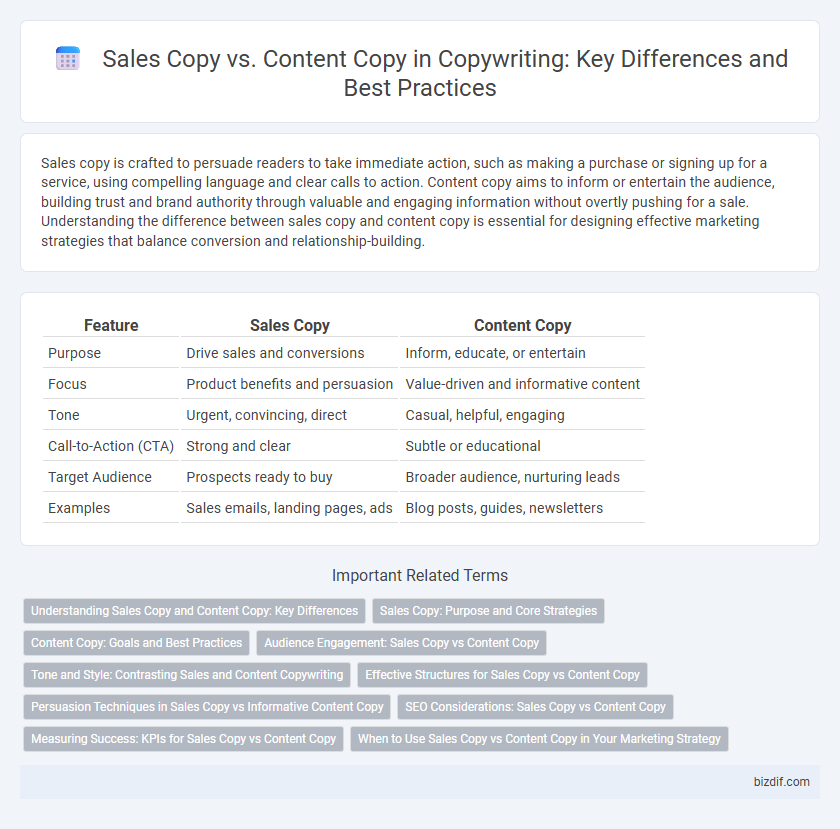Sales copy is crafted to persuade readers to take immediate action, such as making a purchase or signing up for a service, using compelling language and clear calls to action. Content copy aims to inform or entertain the audience, building trust and brand authority through valuable and engaging information without overtly pushing for a sale. Understanding the difference between sales copy and content copy is essential for designing effective marketing strategies that balance conversion and relationship-building.
Table of Comparison
| Feature | Sales Copy | Content Copy |
|---|---|---|
| Purpose | Drive sales and conversions | Inform, educate, or entertain |
| Focus | Product benefits and persuasion | Value-driven and informative content |
| Tone | Urgent, convincing, direct | Casual, helpful, engaging |
| Call-to-Action (CTA) | Strong and clear | Subtle or educational |
| Target Audience | Prospects ready to buy | Broader audience, nurturing leads |
| Examples | Sales emails, landing pages, ads | Blog posts, guides, newsletters |
Understanding Sales Copy and Content Copy: Key Differences
Sales copy is designed specifically to persuade potential customers to take immediate action, often focusing on benefits, urgency, and direct calls to action. Content copy aims to educate, inform, or entertain the audience, building brand awareness and trust over time without overtly pushing for a sale. Understanding these key differences helps marketers tailor their messaging strategies effectively to drive engagement and conversions.
Sales Copy: Purpose and Core Strategies
Sales copy focuses on driving conversions by directly appealing to the target audience's emotions and needs through persuasive language and clear calls to action. Core strategies include highlighting unique selling propositions, leveraging social proof, and creating a sense of urgency to motivate immediate purchases. Effective sales copy balances emotional triggers with factual benefits to maximize customer engagement and sales performance.
Content Copy: Goals and Best Practices
Content copy aims to engage, inform, and build trust with the audience by providing valuable and relevant information rather than directly pushing for a sale. Effective content copy incorporates clear messaging, audience-centric language, and SEO best practices to enhance visibility and reader retention. Consistent use of storytelling, actionable insights, and purpose-driven calls to action improves brand authority and long-term customer relationships.
Audience Engagement: Sales Copy vs Content Copy
Sales copy drives audience engagement by targeting specific pain points and delivering clear calls to action that trigger immediate responses. Content copy engages readers through informative or entertaining material that builds brand trust and nurtures long-term relationships. Effective copywriting balances persuasive sales elements with valuable content to optimize customer retention and conversion rates.
Tone and Style: Contrasting Sales and Content Copywriting
Sales copy uses a persuasive tone with concise, action-driven language designed to trigger immediate consumer response, emphasizing urgency and value propositions. Content copy adopts an informative and conversational style, aiming to engage readers through storytelling and useful information without overt selling. The tone in sales copy is direct and compelling, while content copy maintains a friendly and educational demeanor to build trust and long-term relationships.
Effective Structures for Sales Copy vs Content Copy
Effective sales copy employs a clear, persuasive structure with attention-grabbing headlines, benefits-focused body text, and compelling calls to action designed to drive immediate conversions. Content copy prioritizes informational flow and engagement, using storytelling techniques, detailed explanations, and value-driven content to build trust and nurture audience relationships over time. Structuring sales copy for urgency and clarity optimizes conversion rates, while content copy structures that emphasize relevance and educational value enhance audience retention and brand loyalty.
Persuasion Techniques in Sales Copy vs Informative Content Copy
Sales copy employs persuasive techniques such as emotional appeals, scarcity, and strong calls-to-action to drive immediate consumer decisions and conversions. Content copy prioritizes educating and informing the audience with valuable insights, detailed explanations, and unbiased information to build trust and long-term engagement. Both use strategic language but serve distinct purposes: sales copy focuses on urgency and motivation, while content copy emphasizes clarity and credibility.
SEO Considerations: Sales Copy vs Content Copy
Sales copy prioritizes persuasive language and strong calls-to-action to drive conversions, often utilizing high-impact keywords tailored for immediate engagement. Content copy focuses on informative, value-rich material optimized for search engines with strategically placed long-tail keywords aimed at improving organic rankings. Balancing keyword density and user intent ensures that both sales and content copy align with SEO best practices without compromising readability or effectiveness.
Measuring Success: KPIs for Sales Copy vs Content Copy
Sales copy success is primarily measured by conversion rates, click-through rates (CTR), and return on investment (ROI), highlighting direct impact on sales performance. Content copy focuses on engagement metrics such as time on page, social shares, and organic traffic growth to assess brand awareness and audience retention. Understanding these distinct KPIs allows marketers to tailor strategies that optimize both immediate sales outcomes and long-term content value.
When to Use Sales Copy vs Content Copy in Your Marketing Strategy
Sales copy is ideal for driving immediate action, such as purchases or sign-ups, making it essential during product launches, promotions, or direct response campaigns. Content copy excels in building brand awareness and nurturing relationships by providing valuable information, useful during the awareness and consideration stages of the customer journey. Balancing sales copy with content copy ensures a comprehensive marketing strategy that captures leads and converts prospects effectively.
Sales Copy vs Content Copy Infographic

 bizdif.com
bizdif.com